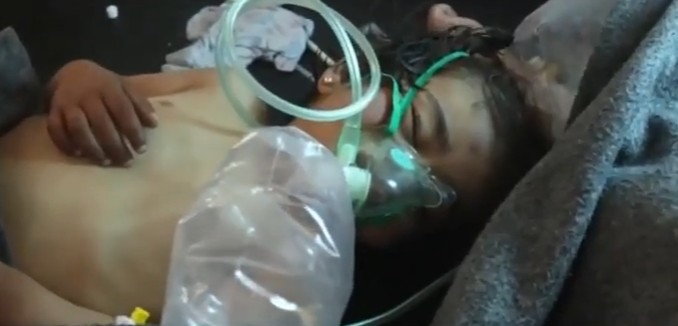At least 58 people were killed in a suspected chemical attack carried out by the regime of Syrian President Bashar al-Assad in the country’s rebel-held Idlib province on Tuesday, a watchdog group and aid workers said.
The Syrian Observatory for Human Rights reported that following air strikes believed to have been carried out by the Syrian military, people started choking and had foam coming out of their mouths, the BBC reported. A Syrian military source denied the charge.
According to medics on the ground, warplanes then fired at medical centers where victims of the attack were receiving treatment.
The initial air strikes reportedly took place at 6:45 AM in the town of Khan Sheikhoun, about 30 miles south of the city of Idlib. Mohammed Rasoul, who runs a local ambulance service, told BBC Arabic that when his workers arrived on the scene 20 minutes later, they found people choking in street. “The situation over there is very bad, and most of those who are suffering are children,” he said.
This photo from #Idlib is like a gruesome Renaissance painting. Can't take my eyes off the sheer inhumanity of this barbarism. pic.twitter.com/auPklNaCmi
— Eylon A. Levy (@EylonALevy) April 4, 2017
Medics said that victims suffered from fainting, vomiting, and foaming at the mouth, the Observatory reported. A journalist with Agence France-Presse said that he saw a number of dead people at a hospital with foam visible around their mouths. He added that the same facility was struck by a rocket Tuesday afternoon, bringing rubble down on doctor treating victims of the morning attack.
PM Netanyahu's comments on the Syrian regime's #chemical weapons attack on civilians near #Idlib. pic.twitter.com/NFw4a4v9SY
— Ofir Gendelman (@ofirgendelman) April 4, 2017
The Observatory put the death toll from the attack at 58, including 11 children. Rasoul, who runs the ambulance service, said 67 people were killed and 300 injured. The pro-opposition Step news agency said at least 100 had died.
David Friedman, a former head of the IDF’s Chemical and Biological Warfare Protection Division, said that based on the images he saw on television, “it seems that it was really a chemical agent and probably sarin.” This would mean that despite the deal to destroy Syria’s chemical weapons stockpile, “probably Assad kept for himself some amount of chemical warfare agents,” Friedman asserted.
If confirmed, the chemical attack would be the deadliest carried out by the Assad regime since an August 2013 attack on a Damascus suburb, which by some accounts killed more than 1,400 people.
Images of children hit with another chemical attack in #Syria are absolutely sickening. We call for an emergency meeting of #UNSC. #Idlib pic.twitter.com/dw0U2DaBjk
— UKUN_NewYork (@UKUN_NewYork) April 4, 2017
Following the 2013 attack, Assad made a deal to get rid of his chemical weapon stockpile. Despite an announcement by then-President Barack Obama in August 2014 that the deal had eliminated Assad’s chemical weapon stockpile, reports persisted that Syria continued using the proscribed weapons. Since the deal, Syria has mostly used chlorine–an industrial chemical that can also be deployed as a weapon–in “barrel bomb” attacks.
The Wall Street Journal reported in July 2015 that American intelligence officials confirmed that Assad remained in possession of chemical weapons, despite the agreement. One of the factors given for the deal’s ineffectiveness was Syria’s ability to control the sites that inspectors could visit.
The director-general of the Organization for the Prohibition of Chemical Weapons, which supervised the destruction of Syria’s chemical weapons stockpiles, wrote in August that his group had collected evidence from over 100 sites inside Syria indicating “potentially undeclared chemical weapons-related activities.”
Ely Karmon, a senior research scholar at Israel’s International Institute for Counter-Terrorism, warned in July 2015 that the failure to fully rid Syria of chemical weapons boded poorly for the success of the nuclear deal with Iran. “If this is the record of the international community in dismantling and monitoring the chemical and nuclear facilities in Syria,” he asked, “how exactly it will do better in monitoring the vast Iranian nuclear infrastructure?”
[Photo: jposttv / YouTube ]




